
|
Sale 17
Coin Auction
| Lot |
Photo |
Description |
Realized |
Lot 129 |
|
Lincoln Cent. A small lot of semi-key date Lincoln cents, 1909-S Lincoln, 1911-S, 1914-D, 1914-S and 1931-S, grades VG t. A nice lot for the album collector. The 1909-S has some spotting, but the others are decent for the moderate grades and toned the expected brown color. Lot of 5 coins.
Estimated Value $100 - 125.
View details
| Realized
$282 |
Lot 130 |
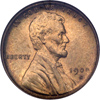 |
Lincoln Cent. 1909-S. VDB. NGC graded MS-63 Red Premium Quality. This coin is very nice for the grade, it is free of spotting or similar copper problems, and the color is a rich, bright red throughout. The surfaces show only faint signs of contact as well. One for the date collector.
Estimated Value $1,000 - 1,200.
View details and enlarged photos
| Realized
$1,725 |
Lot 131 |
|
Lincoln Cent. 1909-S. VDB. Fine-15. Average surfaces for the grade, with woodgrain toning.
Estimated Value $325 - 400.
View details
| Realized
$518 |
Lot 132 |
|
Lincoln Cent. 1909-S. VDB. Sharpness of Fine-12 but scratches removed and scraped. The surfaces on both sides have been scratched and damaged, with scraping on both sides to remove corrosion, traces of which remain. Decent enough eye appeal for an album, but definitely a hole filler.
Estimated Value $150 - 200.
View details
| Realized
$391 |
Lot 133 |
|
Lincoln Cent. 1909. MS-65. Pleasing color and mostly bright save for a small reverse spot on the C of CENT.
Estimated Value $40 - 50.
Purchased from Bebee's March 18, 1959 as "Very Choice, Almost A-1".
View details
| Unsold |
Lot 134 |
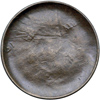 |
Lincoln Cent. 19-- Lincoln cent, obverse brockage with Wheat reverse. AU-50. The portrait of Lincoln has been expanded by subsequent strikes, and only RTY of LIBERTY and 19 of the date is present as well as the outline of Lincoln. The reverse is normal and sharply struck. Good color and a popular error for the Lincoln specialist.
Estimated Value $50-UP.
View details and enlarged photos
| Realized
$118 |
Lot 135 |
 |
Lincoln Cent. 1909-S, S over horizontal S. PCGS graded MS-64 Red & Brown. Mostly red but with some light streaking as commonly seen on these. Boldly struck throughout.
Estimated Value $200 - 250.
View details and enlarged photos
| Realized
$311 |
Lot 136 |
|
Lincoln Cents. 1910-S PCGS graded AU-58, 1921-S PCGS graded XF-45 and 1922-D NGC graded MS-62 Brown. The 1910-S is very nice with traces of original mint color and the 1921-S has the usual wood grain toning. We note the 1922-D has bluish coloring on both sides. Perfect for the date collector who needs these. Lot of 3 coins.
Estimated Value $100 - 125.
View details
| Realized
$184 |
Lot 137 |
|
Lincoln Cent. 1911-S. AU-50. Light brown in color with traces of mint luster. A couple of light hairlines on each side.
Estimated Value $25 - 35.
View details
| Realized
$86 |
Lot 138 |
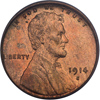 |
Lincoln Cent. 1914-S. PCGS graded MS-64 Red. Well struck with fiery mint red color (PCGS # 2476) .
Estimated Value $1,500 - 2,000.
View details and enlarged photos
Check results on similar lots
| Realized
$1,380 |
Lot 139 |
 |
Lincoln Cent. 1916-D. NGC graded MS-66 Red & Brown. The NGC population reports only 3 in this grade with none higher. A coin for a Registry Set.
Estimated Value $550 - 650.
View details and enlarged photos
| Realized
$604 |
Lot 140 |
|
Lincoln Cent. 1919. PCGS graded MS-66 Red. Well struck with fiery mint red color (PCGS # 2515) .
Estimated Value $350 - 450.
View details
Check results on similar lots
| Realized
$345 |
Lot 141 |
|
Lincoln Cent. 1935-D. PCGS graded MS-66 (PCGS # 2644) .
Estimated Value $30 - 40.
The Benson Collection.
View details
Check results on similar lots
| Realized
$40 |
Lot 142 |
|
Lincoln Cent. 1936. Type 2. PCGS graded Proof 64 Red. A few minor fly-specks are scattered about the obverse (PCGS # 3335) .
Estimated Value $350 - 400.
View details
Check results on similar lots
| Realized
$483 |
Lot 143 |
|
Lincoln Cent. 1937 to 1942. PCGS graded Proof 64 Red. A perfectly matched PCGS set. A total of 6 coins. Lot of 6 coins.
Estimated Value $250 - 300.
View details
| Realized
$575 |
Lot 144 |
|
Lincoln Cent. 1937 NGC graded MS-67 Red and 1938-D NGC graded MS-67 Red. Two superb pieces for the specialist, both spot free and mint fresh. Lot of 2 coins. Two.
Estimated Value $100 - 125.
View details
| Realized
$58 |
Lot 145 |
|
Lincoln Cent. 1939. PCGS graded MS-66. Lot of 13 coins (PCGS # 2677) .
Estimated Value $250 - 350.
The Benson Collection.
View details
Check results on similar lots
| Realized
$184 |
Lot 146 |
|
Lincoln Cent. 1939-S. PCGS graded MS-66. Lot of 5 coins (PCGS # 2683) .
Estimated Value $100-UP.
The Benson Collection.
View details
Check results on similar lots
| Realized
$121 |
Lot 147 |
|
Lincoln Cent. 1943. PCGS graded MS-66. Lot of 25 coins (PCGS # 2711) .
Estimated Value $400-UP.
The Benson Collection.
View details
Check results on similar lots
| Realized
$253 |
Lot 148 |
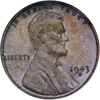 |
Lincoln Cent. 1943. PCGS graded MS-61 Brown Copper. Lincoln Cent Struck on a Bronze Planchet. Accompanied by a PCGS ID #82709 and certification #50035361. From Superior's October 1-3, 2000 sale where it was adequately described as follows:
One of Approximately 20 Known. The Marvin Breyer-1958 A.N.A. Specimen. Since the year of its manufacture, the copper 1943 cent has been a coin that has intrigued collectors and non-collectors alike. The coin offered in this lot is one of the first two discovered. it is a pleasing Uncirculated example with even greenish-golden brown color that exhibits glossy luster over each side. It appears to be completely uncleaned and tarnish-gree, has excellent detail and perfect rims.
Rarities abound in American numismatics but two of the most are the 1943 bronze and 1944 steel cents. Because copper was a strategic metal during the second World War, efforts to find a replacement eventually resulted in adoption of steel with a thin coating of zinc. "Fortunately for some few collectors, but unfortunately for the peace of mind of Mint bureaucrats," reports Walter Breen, in his encyclopedia of United States coins, "at the end of 1942 some bronze blanks were left over in a hopper attached to one of the cent presses, and a least 40 were struck by accident early in 1943, being mixed with a normal production run of steel cents, and managed to leave the Mint undetected. Considering the enormous coinage orders that had to be filled, inspection had to be cursory."
Breyer's coin (the present offering) went into the 1958 ANA Convention auction - only to be withdrawn at the last moment, resulting in loud protests as the auctioneer's book reportedly contained bids well into five figures. In the years since, over a dozen others have been authenticated.
Estimated Value $60,000-UP.
From Superior's Oct. 1-3, 2000 Sale, lot 4146 (realized $60,375.00). This is also the specimen that appeared in the 1958 ANA Convention Auction Sale "A Festival of Coins" cataloged and sold by Abe Kosoff, lot 2055.
View details and enlarged photos
| Realized
$97,750 |
Lot 149 |
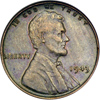 |
Lincoln Cent. 1943-D. PCGS graded MS-64 Brown Copper. Lincoln Cent Struck on a Bronze Planchet. (Actually, called "French Bronze" a composition of .95 copper and .05 tin and zinc). Accompanied by a PCGS ID #82712 and certification #50035362. A very choice uncirculated specimen, sharply struck throughout, with smooth and lustrous chocolate brown surfaces that glimmer as the coin is turned. We note small flecks of zinc imbedded in the reverse field (as struck), possibly this arose from zinc dust and debris from the zinc-steel coins that had preceded it through the coining process. This further attests to the genuineness. A prime opportunity to acquire this absolutely unique example, probably the most famous error in all of numismatics!
"For many years after the war, rumors persisted that the Ford Motor Company would give a new car as a prize to anyone turning in a genuine 1943 bronze cent (usually called '43 copper cent')."
Walter Breen goes on to report that "In early 1947, a Dr. Conrad Ottelin reported discovering a bronze 1943 cent (The Numismatist 6/47, p. 434); this coin either has not become available for authentication, or else has not been connected with Ottelin's name. However, a few weeks earlier, Don Lutes, Jr., then aged 16, found one in change at his high school cafeteria (Pittsfield, Mass.), and I had the pleasure of authenticating the piece when it came to my attention in 1959. It was one of the first to achieve nationwide publicity, the other being Marvin Beyer's, also recovered from circulation (about 1958). Rumors of four-and-five-figure prices followed, but the first public auction of a 1943 bronze cent did not actually result in the coin's changing hands until 1974"
It was not until years later that a single 1943-D copper cent, the present coin offered, entered the market place (see the pedigree below). The coin was authenticated by ANACS with certification #E-8256-C and graded by NGC as Mint State 64 Brown
It has been 7 years since this coin last entered the market place and with the immense growth of interest in numismatic errors, we expect this coin to once again achieve a new record price.
Estimated Value $100,000-UP.
From Superior's May 27,28, 1996 Sale, lot 536 which sold for $82,500 (a record price at that time).
View details and enlarged photos
| Realized
$212,750 |
Lot 150 |
|
Lincoln Cent. 1943-D and 1943-S, both NGC graded MS-67. Lot of 2 coins.
Estimated Value $150 - 200.
View details
| Realized
$92 |
Lot 151 |
 |
Lincoln Cent. 1944 Steel Cent. PCGS graded AU-55. Struck at the Philadelphia mint in 1944 on a zinc-coated steel planchet left over from the 1943 war time planchets. Well struck with traces of mint luster remaining and a light gray in color. A scattering of light deposit spots appear on both sides.Very rare as there are less than 17 known specimens with this example being the second finest known. The finest is a NGC MS-62 which was exhibited at this years F.U.N. Show in Orlando, Florida.
Estimated Value $15,000-UP.
View details and enlarged photos
| Realized
$31,050 |
Lot 152 |
 |
Lincoln Cent. 1944-D Steel Cent. PCGS graded AU-53. Struck at the Denver mint in 1944 on a zinc-coated steel planchet left over from the 1943 war time planchets. This example still retains some lustrer with a scattering of darker deposit spots noted mostly on the reverse. Very rare as there are less than 6 known specimens.
Estimated Value $15,000-UP.
View details and enlarged photos
| Realized
$35,650 |
Lot 153 |
|
Lincoln Cent. 1952. PCGS graded Proof 67 Red. Blazing red color and nearly perfect. PCGS has graded 59 this high with 3 higher (PCGS # 3365) .
Estimated Value $100-UP.
View details
Check results on similar lots
| Realized
$104 |
Lot 154 |
 |
Lincoln Cent. 1954. PCGS graded Proof 68 Red. Totally bright and spot free, as expected for this splendid grade. PCGS has graded 15 as such, with 4 more in each of the Cameo and Deep Cameo grades, and importantly, none have been graded higher! Keep that in mind when formulating your bid (PCGS # 3371) .
Estimated Value $1,000-UP.
View details and enlarged photos
Check results on similar lots
| Realized
$719 |
Lot 155 |
|
Lincoln Cent. 1954 both are PCGS graded PR-67 Red. Lot of 2 coins (PCGS # 3371) .
Estimated Value $75 - 100.
View details
Check results on similar lots
| Realized
$104 |
Lot 156 |
 |
Lincoln Cent. 1955. PCGS graded Double Die Obverse MS-64 Red. Slightly faded mint red in color and quite lustrous. One tiny speck below LIBERTY and with clean surfaces expected for the grade. One of the key dates to the Lincoln cent series, and always in strong demand as few have been found, especially in full red condition. The PCGS Population Report notes 108 have been graded as MS-64 Red with a scant 19 higher, all of which are MS-65 Red above (PCGS # 2827) .
Estimated Value $6,000 - 7,500.
View details and enlarged photos
Check results on similar lots
| Realized
$6,613 |
Lot 157 |
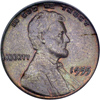 |
Lincoln Cent. 1955. Doubled die obverse. PCGS graded MS-64 Brown. Sharply struck throughout with lustrous glossy reddish-brown surfaces and traces of mint red visable about the devices.
Estimated Value $1,800 - 2,000.
View details and enlarged photos
| Unsold |
Lot 158 |
 |
Lincoln Cent. 1955. Doubled die obverse. NGC graded MS-61 Brown. Medium brown in color and decent for the grade. The doubling is very obvious on the obverse and it's always a pleasure to see a nice example of this dramatic error.
Estimated Value $1,100 - 1,300.
View details and enlarged photos
| Realized
$1,495 |
Lot 159 |
 |
Lincoln Cent. 1959-D The Unique Wheat Ears Reverse! MS-60+. Brown. This coin has created quite a bit of controversy in the past, and it's time the allegations and innuendo get laid to rest. For some reason, the few independent grading services who have examined this coin can't seem to decide on its genuine status, although no one can define any reason to consider it counterfeit, they also won't render an opinion to support the coin as a genuine mint product. Hence, the opinions of most remain that no decision can be made on the coin unless further tests are conducted.
The known history of this unique cent begins in 1986. A retired police officer named Leon Baller advertised in his local Walnut Creek, California newspaper that he would purchase rare and unusual coins. A local coin collector saw the ad and contacted Baller about an unusual 1959-D wheat reverse cent that he had found, and Baller soon arranged to meet with him and then purchased the coin for $1,500. Baller sent the coin to the United States Department of the Treasury for authentication in early 1987. Jim Brown, a forensic lab authenticator for the Department of the Treasury examined the coin and found no indication that it was counterfeit. The coin was returned to Baller on February 7, 1986 with a letter signed by Richard M. McDrew, Special Agent for the Department of the Treasury. The letter states as follows:
"Enclosed is your United States 1¢ coin, dated 1959-D, with wheat reverse. This coin was microscopically examined by our Forensic Services Division in Washington, D.C. and it is their opinion the coin is genuine."
Baller eventually sold the coin to Heritage Rare Coin Galleries in 1987. The cent was then sold to a private collector where it remained until recently.
The current owner of the coin is a business syndicate whose members' names have not been disclosed, and their representative is Larry Choate, a Southern California collector. Choate took the bold move in 2002 to resubmit the coin to the Department of the Treasury and Secret Service for a more comprehensive review of the 1959-D wheat cents authenticity. Choate realized that if the coin was considered a counterfeit, it would be seized and destroyed. In addition, Choate took the risk that the coin was produced at the Denver Mint but illegally spirited out, and could be seized on those grounds as well. Frankly, the Department of the Treasury has a checkered list of such seizures, and only a few coins have been seized over the years. It is important to note here that this coin will not be confiscated as the Treasury Department has returned the coin twice to the owner after reviewing the coin and returning it as genuine. It is also considered legal tender by the Treasury Department.
The most recent and very public seizure was the 1933 double eagle which the Government seized and wanted to destroy in a mindless bureaucratic fashion. Mercifully for collectors, the original owner of the 1933 double eagle was Egypt's King Farouk, and he obtained an export license which allowed him to take the coin with him out of this country to Egypt. After protracted litigation, the government and owner of the coin, British dealer Steve Fenton, agreed to have the coin sold and the proceeds would be divided. Thus, the Farouk 1933 double eagle would be the only currently "legal" specimen that could be obtained. Rumors have long swirled that other 1933 double eagles exist in private collections, but the Government claims title to any that may be in private hands and they would be seized if found as Government officials have publicly stated. This unique rarity just sold for $7,590,020. at auction in July 2002.
In recent years a bonanza of mint "errors" have turned up in collectors hands. Some of these have included error commemorative gold coins which were so mistruck as to not fit into the government holders. Another example would be the recently released Sacagawea/Quarter mules, or even the 1964 Peace silver dollar. Rumors persist, and in some cases these coins would be seized if they appeared at public auction. Normally, years after the original production, the probability of seizure seems to drop, and the seizure cases normally involve coins that were illegally removed from the mint where the perpetrators can be rounded up and jailed after due process, as the coins were simply not just normal production errors which escaped into circulation.
These distinctions are important, because if a coin is seized, it is seldom returned and any value paid for the coin would be lost. Under such circumstances, the Government goes after the mint employees involved, and many have been arrested and prosecuted for these crimes.
Getting back to our 1959-D cent, Choate knew that he was taking a big risk by submitting this coin back to the United States Secret Service, as it could be seized if it was determined to be a counterfeit, or illegally taken from the Denver Mint. However, after extensive examination by the United States Secret Service Office of Investigations Counterfeit Division a report was issued dated May 17, 2002, under their case number Log: 119-726-FY2002-018. This report, which of course accompanies this lot, states as follows:
"Exhibit Examined Q1 One 1959-D Lincoln cent, bearing the wheat reverse, described on the subject letter."
"Background: From 1909 until 1958, the United States Mint cent bore a portrait of President Lincoln on the obverse and two curved stylized heads of wheat on reverse. In 1959, the design was changed to bear the Lincoln Memorial on the reverse."
"Results of Examination Physical and microscopic examinations were conducted on the submitted Lincoln cent (Exhibit Q1; see figure 1). [photo of obverse and reverse].
Page 2:
"Optical and scanning electron microscopic examinations conducted on the submitted coin (Exhibit Q1) revealed that the coin's obverse does not exhibit any indications of alterations to the date or surrounding field (see figure 2). [two scanning electron micrographs of the final 9 of the date are included, the first is enlarged 180 times, the next is enlarged 200 times].
Below these photos the report continues: "Enlargements show no indications of alterations--metal shows smooth transition from numbers to the field. An alteration at these magnifications would be evident by tool mark striations or seams with solder or glue. Alteration from within the coin (embossing) would result in less defined numerals and disturbances on the surface of the numerals."
The report goes on:
"Further, the edge and rim of the submitted coin (Exhibit Q1) was examined for evidence of seams or alterations that would suggest that the submitted coin was a composite of a 1959-D obverse with a separate wheat reverse (see figure 3)." "Figure 3: Micrographs of the rims of the submitted coin (Exhibit Q1)" show the obverse rim near the W of WE, and the reverse rim near a wheat ear and are magnified 60 times. Below the micrographs the Report states: "Enlargements show no indications of alterations or seams. The metal shows smooth transition from the field to the rim and then to the edge. An alteration at these magnifications would be evident by tool mark striations or seams with solder or glue."
Page 3 continues:
"No evidence of manipulation or alteration to the edge of the submitted coin (Exhibit Q1) was observed (see figure 4)." "Figure 4: Optical micrograph of the edge of the submitted coin (Exhibit Q1)" which shows the edge of the coin and concludes: "Enlargements show no indications of alterations or seams in the edge. The metal appears undisturbed, as does the oxidation (toning). An alteration at these magnifications would be evident by tool mark striations or seams with solder or glue."
The Report next examines the die polish lines as follows: "The submitted Lincoln/wheat cent (Exhibit Q1) displays prominent die polish (raised striations in the field, but absent in the raised devices) on the obverse and reverse (see figures 5 through 7). During the course of examination, the subject coin was compared to one 1959 cent and two 1959-D cents that had similar die polish on the obverse. No significant differences in the appearance of the polish were observed." Two greatly enlarged micrographs of the field and ERTY follow: "Figure 5: Optical micrograph of the die polish on Exhibit Q1 and Figure 6: Optical micrograph of the die polish on Exhibit Q1."
Page 4 continues: Figure 7: Optical micrograph of die polish on the reverse of submitted coin (Exhibit Q1)" with a very large micrograph of the central reverse which shows die polish lines in the field.
The Report continues: "Nondestructive physical examinations conducted on the submitted coin (Exhibit Q1) revealed that the coin is consistent in mass, diameter, and thickness of genuine 1958/1959 cent coins. Additionally, surface measurements by energy dispersive x-ray spectroscopy revealed that the coin is consistent in elemental composition with genuine 1958/1959 cent coins (see table 1).
"Table 1: Composition, diameter, thickness, and Mass of Exhibit Q1
Exhibit Cu(%) Zn & Sn (%) Diameter (mm) Thickness (mm) Mass (g)
Genuine* 95.0 5.0 19.05 1.58 3.11
Q1 ~95 - 97 ~3 - 5 19.1 - 19.2 1.5 - 1.6 3.09
*The numbers presented in this row are the Mint specifications for genuine 1947-1962.
Given this evidence, the Report goes on:
"CONCLUSIONS"
"Although the submitted 1959-D Lincoln Cent (Exhibit Q1) exhibits the wheat reverse, instead of the Mint specified memorial reverse, the submitted coin exhibits physical characteristics, such as device detail, metal flow, die polish, thickness, diameter, mass and composition, consistent with genuine 1958/59 Lincoln cents. Further, the submitted Lincoln/wheat cent does not exhibit any indications of alterations to the date or evidence of edge alteration, indicating that the submitted coin was a result of combining two genuine coins. Additionally, no characteristics associated with counterfeit coins, such as tool marks, file marks, raised metal or unusual oxidation ("toning") were observed."
Page 5 begins:
"In the absence of any evidence that the submitted 1959-D Lincoln/wheat cent (Exhibit Q1) is not consistent with having been manufactured by the US Mint, the coin was determined to be a genuine mule cent."
The page continues with remarks which discuss the way the coin was handled, and the fact that it was returned to the owner, and the Report was signed by Marc J. Surrency, Counterfeit Specialist and Approved by Anthony M. Chapa, Special Agent in Charge.
In another specialized reference work, The Authoritative Reference on Lincoln Cents by John Wexler and Kevin Flynn, the authors devote 3 pages to this coin. They note that in 1993 this coin was submitted to the ANA for authentication. Michael Fahey, the examiner at the ANA "could find no evidence of it being counterfeit. However, because there was no evidence the Mint could have produced it and it is hard to conceive how this could happen accidently. Since only one specimen has ever been found, the ANA returned the coin with a "no decision". J.P. Martin, chief authenticator for the ANA, said that when he examined the coin he could not find any evidence that the coin is counterfeit, but also stated that his gut instinct is that the coin is not genuine." J.P. Martin followed up with a letter which is quoted at in full in the Wexler Flynn reference, and we quote the relevant portion here "All in all, the attention given to the die as shown by the die polish is the most bothersome. I challenge any readers to match the shown die polish to the 1959-D obverse or the wheat reverse. Though this piece appears to be suspicious, no absolute technical condemnation can be made. Especially without a comparison example from the same dies. For this reason, the coin was given a "No Decision" by American Numismatic Association Authentication Bureau. This was circa 1993. Since that time, J. P. Martin has left the ANA to be one of the founding partners of the ICG grading service.
J.P. Martin here touches on what will likely resolve the questions swirling about this controversial coin. In 2002 when Larry Goldberg discussed the coin with Rick Montgomery, he said that if other Lincoln cents of the 1958-D reverse and 1959-D obverse dies were submitted, there is a better chance the mule coin could get graded. Given the obvious die lines on the present mule specimen, it should only be a matter of searching to locate matching dies to both the obverse and reverse! It is very unlikely that new dies were used just to coin this one specimen, and the dies were very likely normal production dies which happened to be available when the new reverse was being adapted by the mints.
Okay, let's do some simple math. Walter Breen states in his Encyclopedia that die life for Lincoln cents produced during this period was around 700,000 coins per die (page 233). Mintage for 1958-D cents (it being reasonable to assume the reverse die would have been a 1958-D) was 800,953,000 divided by 700,000 coins per die equals approximately 1,145 dies. Now, let's do the obverse die, 1959-D mintage was 1,279,760,000 divided by 700,000 equals 1,828 obverse dies. Well, while daunting, the task at hand is not insurmountable! Examining circulated coins will not work (I tried that), as the die lines quickly disappear after limited circulation. Thus, this endeavor will best be completed by purchasing bags and bags of 1958-D cents (about $5 per roll of 50 coins) and bags and even more bags of 1959-D cents (about $1 per roll) and quick examination of the coins will hopefully produce an exact match to the unique die lines seen as a signature on this coin. Matching the two dies from regular issue coins to this mule piece will prove that the coin was struck from genuine Denver Mint dies, and given the absolute assertion that the coin is genuine by the United States Secret Service Counterfeit Division it would be hard for anyone to refute the coins authenticity. Once the dies are matched up, we are confident the grading services will have to certify and grade the coin as a genuine Mint product.
How did this coin come about? It is very difficult to imagine that somehow just one slipped out and got into circulation, although anything is possible given the massive production of coins each year at the Mint (stranger things have happened). It was more likely made during a quiet moment at the Denver Mint, under similar circumstances to the one known 1943-D copper cent, a special striking as it were, not unlike dozens and dozens of other famous rarities produced during the last 209 years at the various United States mints.
Valuing this unique cent is virtually impossible. We feel confident that it will bring less than the similarly unique 1933 double eagle at $7,590,020. Perhaps it will bring a price similar to the unique 1943-D copper cent, which realized $82,500 way back in 1996 at a Superior Sale, or the more current example of the extremely rare 1943-S copper cent which was NGC MS-61 Brown which realized $115,000 in our February 2000 Sale.
For those out there in coinland who have the time and inclination, the dies could quite possibly be matched up just from the photos in the Wexler Flynn reference, or from the photos in this catalog, prior to the auction of this coin in September. If there isn't time, it is likely the matching dies could be found and the coin resubmitted with the additional evidence and a copy of the Treasury Report.
In particular, please note the die lines which should be easy to match up when compared with other mint 1958-D and 1959-D cents, on the obverse look for the die line which connects the lower loop of the B in LIBERTY to the upper half left side of the upright of the E. The reverse is very easy to identify, there is a long die line from the middle serif of the F in OF up to the center of the upright of the E in CENT. Also, we note two or three parallel die lines extending down at an angle from the left wheat ear near the top. These are very clearly visible on the coin under magnification, and are also seen in excellent detail on page 335 of the Wexler Flynn reference book.
While controversial, this coin seems to be turning the tide in its favor with the Treasury Report, and with a little research, could soon be die linked to other existing 1958-D and 1959-D cents, which will likely lay the controversy to bed, and the coin can finally be accepted by the grading services and other experts in the Lincoln cent series.
As the controversy still swirls around this mule, the major grading services have chosen NOT to grade this coin as of yet. Nevertheless, we feel that if someone took the time to locate other examples of the obverse and reverse dies which were used for normal production coins, combined with the more thorough Secret Service Authenticity Report of 2002, there would be a better chance that the coin may get graded in the future.
The property is not guaranteed to be authentic, and is marketable as is, and can not be returned.
Estimated Value $25,000-UP.
View details and enlarged photos
| Realized
$48,300 |
Lot 160 |
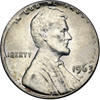 |
Lincoln Cent. 1963 Lincoln cent struck on a dime planchet. MS-63. The weight on this one is pretty close at 2.52 grams with a normal dime planchet at 2.50 grams. This one is fairly sharp throughout, with just a few areas of minor weakness in the lettering. Good luster and well preserved.
Estimated Value $200 - 300.
View details and enlarged photos
| Realized
$1,035 |
Lot 161 |
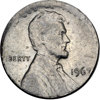 |
Lincoln Cent. 1967 Error Lincoln cent, possibly struck on a dime planchet or some other sandwhich metal coin. MS-60+. This one weighs 2.32 grams, so it's a bit light for a dime planchet, but has the copper core showing on the edge. Weakly struck from the thinness of the planchet, with peripheral lettering weak. An exciting error coin.
Estimated Value $100 - 150.
View details and enlarged photos
| Realized
$230 |
Lot 162 |
|
Lincoln Cent. 1995. Doubled die obverse. NGC graded MS-67 Red.
Estimated Value $50 - 75.
View details
| Realized
$40 |
|
|